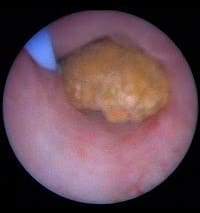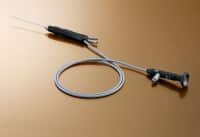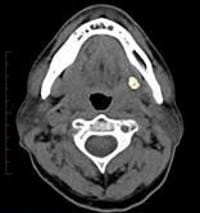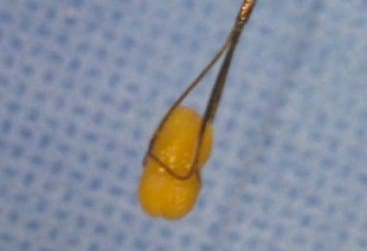Do you have pain when eating, swallowing, or speaking? Salivary stones can disrupt the normal flow of saliva and cause extreme pain and infection in the mouth. Sialendoscopy is a revolutionary, minimally invasive technique to remove salivary stones without extracting the entire gland.
As one of the first practices in the area to offer this procedure, ENT Specialists of Austin provides this procedure to patients at the Austin and Cedar Park, Texas locations. To book a consultation with our team of Physicians call or schedule an appointment online.
Sialendoscopy Q & A

Example of the endoscopic appearance of a stone
What is Sialendoscopy?
Sialendoscopy is a procedure that utilizes minimally invasive technology to extract stones from salivary glands without the need to remove the entire gland. Dr. Nason was the first physician in Austin to perform this highly technical surgery.
The technique uses semi-rigid endoscopes, or lighted cameras, that are small enough to fit into your salivary ducts. Once they’re in the ducts, your physician can accurately identify the cause of salivary problems or disease.
If you have a salivary stone, this procedure also allows your physician to access the stone, break it into smaller pieces, and remove it without injuring nearby nerves.
When is Sialendoscopy Necessary?
Sialendoscopy is usually performed if a patient has salivary stones. These small masses grow inside the salivary glands and affect about 1% of the general population.

Example of a sialendoscope
The exact cause of salivary stone formation is unclear, but the stones can obstruct your natural flow of saliva and cause pain or swelling. Bouts of pain can come on unexpectedly, and the condition can significantly interfere with your quality of life and your ability to eat, swallow, or even speak.
Many people receive antibiotics for the condition, which don’t help to resolve the underlying problem.
Other symptoms of salivary stones may include fevers, chills, and dry mouth. Eventually, the obstruction can lead to gland infection, which may cause long-term oral health problems.
What are the Benefits of Sialendoscopy?

Example of the CT scan appearance of a stone
Sialendoscopy has revolutionized salivary gland surgery because it has dramatically reduced the need to remove a salivary gland entirely. Research shows the procedure has a success rate of about 85-95%.
With sialendoscopy, patients can avoid the risks associated with open gland removal, including injury to the facial or lingual nerves, scarring, facial deformities, and bleeding. This minimally invasive procedure also requires no hospital time, and there is no need for wound care or extended recovery time.
Under the expert care of experienced head and neck surgeons, you can guarantee that your sialendoscopy will deliver the results you need without the complications associated with traditional salivary gland surgery.
For a consultation about sialendoscopy at ENT Specialists of Austin, call the office or schedule an appointment online today.

